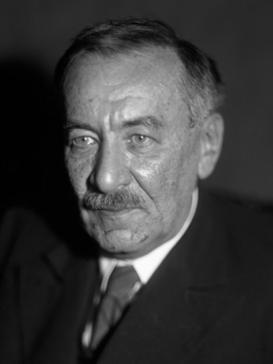Leonid Mandelstam facts for kids
Quick facts for kids
Leonid Mandelstam
|
|
|---|---|
 |
|
| Born |
Leonid Isaakovich Mandelstam
4 May 1879 Mogilev, Mogilev Governorate, Russian Empire
|
| Died | 27 November 1944 (aged 65) |
| Scientific career | |
| Doctoral advisor | Karl Ferdinand Braun |
| Doctoral students | Aleksandr Andronov, Mikhail Leontovich, Igor Tamm |
Leonid Isaakovich Mandelstam (born May 4, 1879 – died November 27, 1944) was an important Soviet and Russian physicist. He is known for his work on how things vibrate and for discovering a special way light scatters. This discovery is now used in many scientific fields.
Contents
Life of Leonid Mandelstam
Leonid Mandelstam was born in Mogilev, which was part of the Russian Empire and is now in Belarus. He started studying at Odesa University in Odesa. However, he was asked to leave in 1899 because of his involvement in student political groups.
He then continued his studies at the University of Strasbourg. He stayed in Strasbourg until 1914. When World War I began, he returned home. In 1942, he received the USSR State Prize, a very important award. He passed away in Moscow at the age of 65.
Amazing Discoveries in Physics
Leonid Mandelstam's main work focused on the study of oscillations. This is how things vibrate or swing, like a pendulum. His work also included the study of optics, which is about light, and quantum mechanics, which looks at how tiny particles behave.
He helped discover something called combinational scattering of light. This is a special way light changes when it hits something. Scientists now use this discovery in a method called Raman spectroscopy.
How Light Changes: A Big Discovery
In 1918, Mandelstam predicted that light would scatter in a certain way when it hit tiny sound waves. Later, in 1926, Mandelstam and his colleague Grigory Landsberg started doing experiments. They wanted to see how light scattered when it hit crystals.
On February 21, 1928, they made an exciting discovery. They found the effect of combinational scattering of light. They shared their findings for the first time on April 27, 1928. They quickly published short reports about their discovery.
At the same time, two Indian scientists, C. V. Raman and K. S. Krishnan, also saw light scattering in a similar way. Raman said he first saw this new light on February 28, 1928. This means Mandelstam and Landsberg observed it about a week earlier.
However, the discovery became known as Raman scattering or the Raman effect. This is because Raman and Krishnan showed that this effect happened in solids, liquids, and gases. This proved it was a universal effect, not just in crystals. Their method also became very useful in many areas of physics.
Inspiring Future Scientists
Leonid Mandelstam started one of the two main schools for theoretical physics in the Soviet Union. He was a mentor to many bright students. One of his most famous students was Igor Tamm. Igor Tamm later won the Nobel Prize in Physics.
Igor Tamm then mentored other famous scientists. These included Vitaly Ginzburg, who also won a Nobel Prize, and Andrei Sakharov. Sakharov is known as the "father of the Soviet hydrogen bomb" and also won the Nobel Peace Prize.
A crater on the far side of the Moon is named after Leonid Mandelstam. This honors his important contributions to science.
See also
- Brillouin scattering
- Quantum tunnelling
- Quantum speed limit

